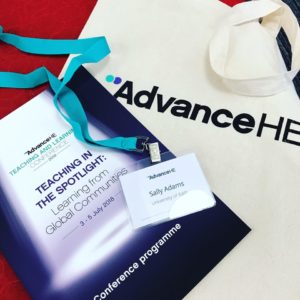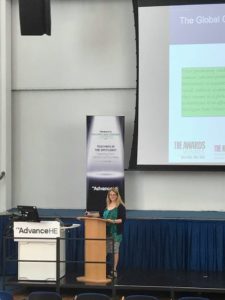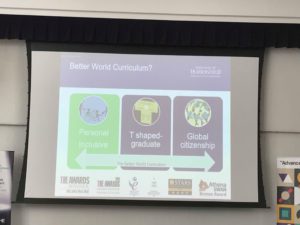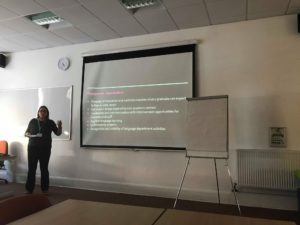Last week I attended the first Advance HE Teaching and Conference (Formerly the Higher Education Academy) held in my hometown of Birmingham. The conference attracted over 600 participants over 3 days, indicating a keen appetite for learning and teaching in a climate where many institutes are undertaking curriculum redesign and transformation. I attended the first day of the conference targeted at academics and professional services staff working in arts and humanities and health and social care. The overarching theme of the conference was “Learning from Global Communities” with a keynote lecture from Professor Christine Jarvis from Huddersfield University on “Growing Global Graduates: Teaching for a Better World”. At the beginning of her talk Professor Jarvis asked us to think about several questions: “What do graduates need for the coming decades and centuries?”; “What does a global graduate look like?”; “What skills and attributes do they need?”; and finally “What do educators need to build a curriculum that produces global graduates?”


Conference Ready! Keynote from Professor Jarvis
Professor Jarvis indicated that current definitions of global graduates are driven by employability, but followed this with a suggestion that we must shift to see the world through a wider lens. Global graduates require skills in inter- and cross-disciplinary team working, cultural awareness, problem solving and critical thinking in addition to subject-specific intellectual capability. The “T-shaped” professional model is one way of meeting these needs, where the vertical arm of the “T” represents discipline specific knowledge and the horizontal bar represents skills and attributes that are important in the workplace, including: leadership, cultural awareness, teamwork, emotional intelligence and complex problem-solving. Professor Jarvis also suggested we need to prepare graduates to be “Ready to make the world, not just respond to it”, armed with a skill set that allows them to manage global challenges of their time. The curriculum we build must enable graduates to be critical thinkers and agents of change. We as educators must encourage students to ask questions about the world and to engage with the public and community, and this can be achieved by starting with the students rather than starting with the subject in curriculum development. Curriculum should be shaped by interdisciplinary courses and assessments, and communication with different groups. Ultimately, global citizenship should not be an add-on, but a case of helping students to engage with and understand problems of the “real-word”.

The "T shaped" graduate
The first parallel session of the day I attended was “Make ‘em laugh!”: The use of anecdotal stories and laughter in the classroom: A teaching perspective. Neil Dougan and Dr Sarah Telfer from the University of Bolton chaired a lively and thought provoking workshop covering the benefits and pitfalls of using anecdotes and stories in the delivery of written and verbal teaching content. Both speakers shared their own experience of using stories and humour as teaching tools, acknowledging that “we are wired for communicating through learning from stories” Narrative teaching was described as a method using a teacher’s own experiences as a pedagogic tool to build communication in the classroom. We took part in several activities that could be used as narrative communication tools in the classroom. First, we were asked to tell the person next to us something “unusual” about ourselves, followed by choosing a photo from our phone to talk about an experience. These activities are designed to promote sharing and empathy as key resources in the classroom. Moving onto humour we learnt how laughter can be important in establishing teachers as “real people” and for bringing authenticity and credibility in teaching. Several studies have shown that humour is cognitively and pedagogically effective. However, caution must be taken in ensuring humour is culturally appropriate and sensitive. It is important to be aware who your audience are and to use “constructive humour” that is not hostile or “bullying”.
My second workshop of the day focused on “Embedding digital health capabilities into curricular” led by Dr Christine Slade and Professor Christine Brown from the University of Queensland. At the beginning of the session we were advised to not make assumptions about students’ competence and confidence with digital domains. We were also asked to think about “What are the key digital attributes that students should have?” and “What tools do we need to teach these capabilities?” Using the Digital Capabilities Framework: The Six Elements (JISC, 2017) we worked in groups to design a classroom activity or assessment around one of the six elements of digital capability: Information and Communications Technology (ICT) proficiency, digital learning and development, digital creation, innovation and scholarship, digital identity and wellbeing and communication, collaboration and participation. We were asked to bear in mind what key digital capabilities would we want our students to have by graduation. The exercise was useful in providing guidance in the use of digital tools, thinking about the quality and credibility of digital resources, who they are aimed at, and the pros and cons of using different digital tools.
The final session I attended was an oral presentation by Ilse Renaudie from the University of East Anglia on “Learning through engagement beyond the classroom”. This session outlined the important intersection between theory and practice by using activities where students can learn that application of knowledge is important from the beginning of a course or programme. Engagement beyond the classroom can give students an understanding of the value of their subject in the community and at an international level. Opportunities for engagement include: collaborative projects with stakeholders, curriculum design informed by non-academic content and using a diverse range of methods that graduates can expect to use in their career. Additionally, we learnt that non-academic engagement can place a student in the learning experience as an active agent and allow them to engage with the needs of a non-HE partner. This is an area of learning and teaching that greatly interests me and is the subject of a Teaching Development Funded (TDF) project I am working on with Katie Maras. This session has certainly given me food for thought in terms of trialling and integrating novel and innovation public engagement methods in our TDF project and beyond.

Ilse Renuadie discussing engagement beyond the classroom
I would highly recommend the Advance HE conference on learning and teaching for anyone wishing to integrate innovation, diversity and collaboration into their teaching and curriculum. The conference offers a fresh perspective on teaching and learning in HE, with national and international teaching colleagues getting together to share experiences and ideas.
Respond